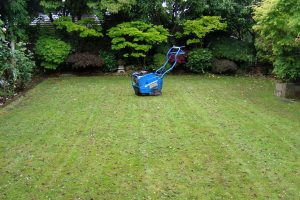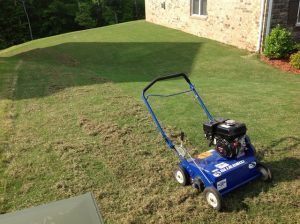AERATION: Aerating a lawn is usually recommended when the soil becomes compacted and water and nutrients can’t get to the roots of the plant. Lawn aeration equipment will pull “cores or plugs of soil out of the ground, letting air in. These plugs should be 2-3″ in depth. Such a plug should be pulled out of the lawn at about every 3”. The plug-removal process is facilitated by watering the lawn the day before, but don’t water to the point of muddying the soil. One of the most frequently made mistakes is the lack of sufficient cores or plugs removed from the lawn. If the tines of the aerator are set more than three inches apart, and only one pass is taken on the lawn, the effort may not have been sufficient to solve the problem. Two passes may be required to ensure that air, water and nutrients can get down to the roots. Take care to mark all sprinkler heads so that they can be avoided with the aerator. This will save on costly repairs to the irrigation system.
Recommendation: Core aeration, a process where plugs of soil and grass are removed at regular intervals, can be done either by renting equipment or hiring a professional. A cool, dry fall day* (or in the springtime) is the perfect time for this beneficial chore. Core aeration reduces compaction in heavy clay soils, permits a more rapid exchange of oxygen and water with grass roots and reduces the thatch layer on lawns. Remove all grass plugs after aerating to compost pile or dispose. Or if you are dethatching you can thatch the plugs afterwards. We recommend thatching every other year.
DETHATCHING: Thatch is that tightly packed layer of dead and living shoots, stems, and roots that develop between turfgrass and soil surface. As it is, dethatching takes a little time and effort and using the wrong dethatching equipment can make it a Herculean effort when it needn’t be. Some dethatching machines have flexible, leaf rake-type tines that are ineffective in removing thatch. Spring tines that attach to a rotary mower blade aren’t good for dethatching and can damage your mower. It’s important that you use the right equipment if you are going to dethatch. Don’t attempt to remove the entire thatch layer in one treatment and do not dethatch when soil is wet; only dethatch your lawn when it is needed rather than on a routine basis.
Recommendation: A little thatch is desirable, since it helps moderate temperature extremes at the soil surface and provides a cushion effect on the surface but too much thatch can present some negative consequences. To determine if your lawn has a thatch problem, remove a small, plug of turf several inches deep. Note the spongy layer of material between the turf and soil. If this layer is more than 3/4 to 1 inch thick when you compress it, you should consider having your lawn dethatched*. If you need to dethatch your lawn there are garden centers and equipment rental outlets that rent dethatchers. These machines are know as vertical movers, verticutters, dethatchers or power rakes and they have vertically spinning blades which pull some of the material to the surface as they slice the thatch layer. Mechanical dethatching should be done in* springtime, before the lawn comes out of dormancy*. As is the rule when operating any equipment, follow the manufacturers or rental store’s operating procedure. The organic material dislodged by the dethatching machine should be removed and composted. Its also important to note that grass clippings do not cause thatch*. Remove all thatch from the lawn either by rake, vacuum, or mower bag to compost pile or dispose of.
*Where the asterisks appear, McPheeters Turf, Inc. has adjusted, subtracted or added comments to better coincide with our climate, zone, turfgrass types, and locally relevant experience.* To see the article in complete and non-adjusted state see The Lawn Institute’s website, and find the article “Five Common Lawncare Mistakes”.
http://www.thelawninstitute.org


